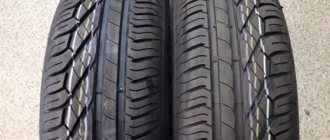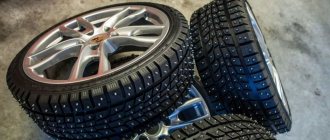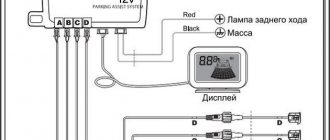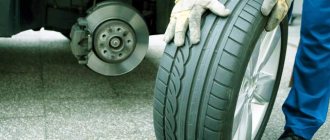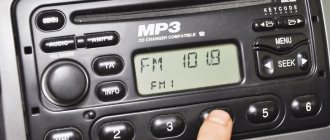When buying new tires for their car, most motorists want to use them for a long time. What they care about most is how many kilometers the tire will travel before it wears off.
Factors that affect tire durability
It is worth noting that the service life is determined not only by the manufacturer, but also by driving style. During acceleration, sudden braking, and cornering, the tires undergo greater pressure.
Tires should be used for their intended purpose. “Fast” shoes always last less than “slow” ones.
Tire mileage is affected by age. Manufacturers promise that tires will not deteriorate in their performance over 3-5 years, but temperature changes, climate, and storage conditions can negatively affect rubber and other components.
Manufacturers write a treadwear index, which they want to tell the buyer how long the purchase will last. But you shouldn't rely on it completely. Firstly, not all companies are ready to honestly write real data. Secondly, in practice there are many factors that can reduce this indicator. For example, the heat resistance of tires, tread characteristics, and others.
While placing the main emphasis on wear resistance, remember that long service life comes at the expense of grip quality and noise.
Manufacturers rating
Assessing wear resistance is quite difficult. Most ratings are based on the subjective assessment of car owners, which is influenced by the factors described above. It becomes obvious that the same tires will show different results for each motorist.
When testing tires by well-known publications, the durability parameter is not always mentioned. And online users sometimes leave opposite reviews about the same brand. However, an attempt has been made to use all possible sources of information. The ranking presents five companies that are the most famous and have durable tires. It is worth considering that all indicators depend on the specific model.
Michelin
The first place should be given to the French company. In 2020, the famous American magazine Consumer Reports named the tires of this brand the best. Not only wear resistance indicators were assessed, but also grip and handling. Thanks to its unique tread pattern, Michelin was able to achieve a reduction in rolling resistance and, as a result, a reduction in fuel consumption.
In another ranking conducted in Germany, Michelin tires showed the highest fuel economy. Compared to other manufacturers, it could reach 7%.
The Que Choisir association also tried to find out the most durable tires. Her survey included 34,000 respondents. The prize was given to Michelin. The Belgian organization Test-Achats obtained an identical result. The only drawback of the tires is the high price.
Goodyear
Goodyear tires are given second place of honor due to the high positions in the ratings mentioned above, as well as reviews from Russian car owners. The company has its own technology for forming a double layer of treads, which provides high wear resistance, as well as good grip on wet roads.
Continental
The company earned its third place thanks to high positions in various independent ratings and positive reviews. Every third car in Europe is equipped with Continental tires. What is also important is that the manufacturer puts safety first. More than a thousand scientists work every day in Germany to innovate and test finished tires.
Cooper
The American company was included in the rating due to the high wear resistance of its tires. They are able to withstand high loads and travel on uneven roads. At the same time, they provide good handling and maneuverability.
Kama Euro
Tires from domestic manufacturers are, of course, inferior to other famous brands. They are noisier and the grip is not the best. There are complaints from car owners about handling in winter. However, most consumers characterize Russian tires as inexpensive and durable.
Conclusion
Tires can affect your ride quality in many ways. When choosing the most wear-resistant tires, do not forget about other characteristics. Safety on the road comes first.
Source www.anytyres.ru
The head of the “Behind the Wheel” tire test group, Sergei Mishin, answered questions from our readers about summer tires on the eve of the spring-summer re-shoe season.
How to choose the right tires and not overpay, how to navigate tire labeling, is it worth buying used tires? Sergei Mishin, head of the tire test group of Za Rulem magazine, answered these and many other questions about winter tires online in the fall. In the spring we opened a new round of the tire hotline.
test_shin_2
Andrey: I want to install Cordiant Off Road 205/70 R15 on the Chevrolet Niva. The car is often driven off-road. Is it okay in winter at all?
I believe that the expression “not at all” regarding this tire can be used for any hard surface, even in summer. That is, on an asphalt road, these tires are suitable for moving from one muddy area to another. It will be even worse in winter. In deep snow, these tires will help if the weather is not very frosty. If there is a strong minus, the rubber will freeze and become stiff, losing elasticity.
On slippery surfaces (ice, compacted snow) it is simply dangerous to ride them - they will behave almost like slicks. The number of edges that the Cordiant Off Road can catch on micro-irregularities is literally minuscule. On slushy snow you can only move by walking. If you go a little faster, the car will start to yaw and may lose control.
Artem Artemov: Tests do not make it clear how many kilometers the tire will run, but I would like to. The harder the rubber compound (Shore), the longer the wheel will travel, right? By the way, does ADAC somehow test tires for wear?
Theoretically correct, all other things being equal, but too exaggerated. To some extent, this is true only for extreme modes with deep slides.
In life, during normal driving, this is often not the case at all. Wear is influenced by many factors, in particular the distribution of specific pressure in the contact patch, the chemical composition of the tread rubber, etc. If everything were so simple, all tire companies would produce “long-lasting” tires. In the meantime, no one can catch up with Michelin tires in terms of service life.
Another important issue for Russia is broken roads. Our tires are more often killed in pits. Therefore, their resource is often limited by the probability of damage. No tests will tell you how many kilometers a tire will run. They can only show the difference in mileage between different tires, and under the same conditions. Wear tests with reliable results are a very expensive pleasure that domestic publications cannot afford, especially in times of crisis.
Tire wear – how long do tires last?
Each of us sooner or later faces the question: “Are my tires wearing out quickly?” It is not easy to answer this question, because tire wear is influenced by a large number of factors, among which, almost in the first place, will be the driving style of the driver himself. In addition to the driver's driving style, tire wear is also affected by the type of drive and engine power. For clarity, I will give an example from my own operation. With the advent of the Fiat Grande Punto 1.4 t-jet turbo cockroach in the family, the style of daily driving changed dramatically, because now it was possible to get adrenaline in small doses, but every day.
And on major holidays, fuel yourself with pleasure by driving the Omega 3.0V6 kompressor. Now it has become easier to compare the behavior of tires on cars with different types of drive and, at the same time, understand how long tires last in active driving mode. Despite the presence of a set of 205/45R17 RE050A tires for Fiat, in order to preserve the suspension on our roads. It was decided to run it most of the time on 195/60R15 Kumho KH17 tires, and a little later on 185/65R15 Kumho KH25 tires. 195/60R15 Kumho KH17 is made in Korea and has been repeatedly noted by ADAC magazine as especially recommended. Among the additional pleasant characteristics is high wear resistance. Although tire wear is not the first priority for me, because... I still want to try something new every year. The supercharged engine of a light car can easily cause the tires to slip into deep slip even on dry asphalt, so in active driving mode the tire service life should in any case decrease, but by how much and from what figure is difficult to say, it’s easier to look at what happened after seasonal use. The baby's daily runs are 110-150 km. Because I live outside the city, and very often I exceed the speed limit on an empty section of the highway to a pleasant 160-200 km/h. The two 195/60R15 Kumho KH17 tires remaining from the full set ran about 26,000 km at the end of the summer season! The last ten thousand were running on the rear axle. As you can see, outwardly they look quite decent.
This particular tire was made back in 2009. at the end of the year at 46 weeks. I bought them in the fall of 2011 from leftovers at the end of the season when the Fiat was purchased. I took what I had without worrying, because... Our tires are stored in concrete warehouses without access to light and without high-temperature surges in the heat.
But appearance is appearance, and we will measure tire wear with a simple, but accurate enough for the average person, depth gauge. The initial tread height of tires in size 195/60R15 Kumho KH17 is 7.3 mm (depending on the size and model of summer passenger tires, the tread height can vary on average from 6.5 to 8.5 mm). In the photo, the central treadmill has a residual depth of about 4.5 mm. with a tire mileage of 26,000 km.
The tire wear at the edges is slightly less than 5 mm. The reason for the difference in wear is very easy to explain - the tires have always been operated at an increased pressure of 2.4-2.5 bar in order to improve handling and increase resistance to impacts.
It is easy to calculate that over 26,000 km the tire tread has worn out by only 2.5 -2.8 mm. If the pressure was in the comfort zone - 2.2 bar, then the residual tread height would be at least 5 mm. This means that for every thousand km. Tread wear averaged 0.1mm or less! An excellent indicator considering the harsh use of tires, both in the city and beyond. If you continue to use the tire in the same mode, then with an estimated residual tread wear of 3 mm, the total tire mileage can be more than 45,000 km! Very good result. If you change your driving style to moderate without sudden acceleration and high speeds, then this figure will easily increase by 20-25%! I remember that our previous Opel Corsa D with a 1.2 engine + robotic gearbox barely wore out 185/70R17 KUMHO KH17 to:
6mm rear – for 48 thousand km! Such high levels of wear resistance were facilitated by a weak 80-horsepower engine and a smooth gearbox robot, which did not allow sharp shifts and killed the driver’s drive already in the bud. In the photo it is still practically new, although it has already run several thousand km.
At the end of the summer, the Kumho KH25 185/65R15 tire model (interchangeable size with 195/60R15) was installed on the front axle of the Fiat to determine the grip and service life characteristics. The initial tread height is about 185/65R15 KH25 7.5 mm.
Shina
Artem Artemov: Light alloy wheels sometimes “cut” the tire - will switching to a higher load index help solve this problem? And what are the risks of such a transition?
It will help to some extent. As an example, I can give foreign cars sold in Russia: most of them today have an excessive load index.
Nothing terrible will happen - the car will become a little stiffer and less comfortable. But hardly anyone can answer the question of how much the probability of sidewall breakdown will be reduced.
At the same time, excessively hard tires will negatively affect the life of the suspension elements, since the load on them will increase.
Life experience tells me that the most durable tires are usually Bridgestone. But due to their thick sidewalls, they are also usually the heaviest, which negatively affects the vehicle's fuel efficiency.
Alexey: When changing wheels seasonally, tire fitters swapped the left and right wheels so that they rotated in the opposite direction from the correct direction. I felt better vehicle stability and increased wheel noise. Tell me, besides rapid wear and tear, what did I risk from a safety point of view?
Absolutely nothing if these tires are not directional. When the tire rotates in one direction, when starting and braking, its tread over time becomes likened (of course, exaggeratedly) to a kind of ratchet that slips slightly in one direction. And now it has been forced to rotate in the opposite direction - of course, the protruding “corners”, bumping into the asphalt, will make additional noise. But not for long until the tread wears in and takes on the appearance corresponding to the direction of rotation. If you have driven about 100–300 km, depending on driving modes, there is no point in turning the tires over, since you will step on the same rake.
If the tires have a directional pattern and are installed in the opposite direction, water in puddles will not be removed from the contact patch. The car may float up at low speed and lose control. On a dry road nothing critical will happen.
Ilya Zyamzin (question from a member of the VKontakte group): What is the essence of balancing wheels with bead-type balls and for what purposes is it more profitable to use this method. Are there any disadvantages?
As I understand it, the essence is the same as when using liquids or gels for balancing. At high speed, the system (!) “tire + balls/fluid/etc.” self-balances under the influence of centrifugal forces. In fact, such proposals have not found wide application in passenger tires. I don’t believe in such “lazy” balancing: in my opinion, it’s unreliable, and even if it works, it doesn’t last long.
What mileage are summer tires designed for?
In order to understand how much mileage you need to drive before the next tire change, you need to clearly understand which route you will have to travel on and under what operating conditions this will happen, including all loads. Today, not a single manufacturer, even a world-class one, will tell you the exact number, expressed in kilometers, after which the tires must be changed to new rubber. In the best case, a phrase may be heard in the response letter stating that the expected mileage, which is preliminarily calculated at the tire testing stage, can be thirty thousand kilometers, there is a probability of deviation from this indicator by plus or minus thousand kilometers and this is true for both summer tires and and for winter tires. However, summer tires are sometimes forced to travel on too hot asphalt and this makes the wear rate even higher. Winter tires always travel on cold roads and it is important not to leave them on the wheels when full winter sets in.
It must be said that many large tire companies do not consider tire wear as a main parameter. They are determined to improve quality and reliability, first of all, as well as to achieve a high level of safety from the use of their products. But there is an opinion that tires can officially be used for ten years from the moment they are released from the assembly line. Even if tires have not been used in the first five years, they can be installed on a car if stored properly. The manufacturer indicates the tire production date on the side of the tire under the DOT sign, where the first two numbers indicate the week the tire was produced, and the remaining two digits indicate the year of its production.
Interesting: How to store cabbage in a vegetable pit
Since we are talking about wear and tear, it is important to consider what factors influence this indicator:
1) With a driving style such as sharp acceleration and sharp braking, the degree of wear increases by sixty to seventy percent. 2) With regular driving on uneven roads covered with crushed stone and tar, the degree of tire wear is also reduced by at least forty percent. 3) When driving at high speeds, the tire may also wear out faster. 4) When driving on high-temperature roads, the rubber also wears out quickly. 5) If the load due to cargo transportation is increased by at least twenty percent, then the degree of tire wear will increase by thirty percent. 6) Reducing the pressure inside the tires by at least ten percent also reduces wear.
Experienced car owners, having repeatedly experienced in practice the degree of wear of car tires, today choose the most reliable and durable ones, paying attention to the degree of safety. There is a category of careful drivers who manage to drive on one set of tires for one hundred to one hundred and thirty thousand kilometers using imported tires and sixty to eighty thousand kilometers on domestic tires.
But they: 1) Followed all the rules for rearranging wheels, thus reducing the degree of wear by twenty to thirty percent on imported cars and by ten to fifteen percent on domestic cars. 2) When rearranging wheels, use a full spare wheel. 3) Rearrange the wheels without changing the direction of rotation of the tire every ten to fifteen thousand kilometers.
If owners of modern cars prefer to use two types of tires - winter and summer, then based on average indicators, in which each set is designed for approximately one hundred thousand kilometers, they will last for eight years. But in practice, everything may be different, since there are still situations that lead to complete rupture of the rubber after a severe accident. In such a situation, there is no need to look for a way out, how best to glue and repair it, but it is better to go and buy new winter or summer tires in Voronezh, realizing that they need rolling.
Modern tires today are produced taking into account all factors that can affect speed, safety, braking, and handling characteristics. There are summer tires that have a multi-layer layer, which, as it wears, does not lose its grip properties, which is important for lovers of high-speed driving in any weather. However, you should not hope that too high speeds in heavy rain will protect you from getting onto a slippery section of the road. It is important to follow all the rules of caution and then any movement on the road and in any weather will be a joy, and not the result of an emergency situation.
When determining the degree of wear of a summer tire, you should pay attention to the tread height. If they approach the two millimeter mark, then the tire should be replaced urgently, avoiding additional and unnecessary risks. It must be said that fans of high-speed driving prefer to ride on already worn tires, since they exhibit maximum performance in fast movement. But the rules for changing tires when the wear mark is reached are the same for everyone and are not disputed, so they must be followed.
Modern tires today are produced taking into account all factors that can affect speed, safety, braking, and handling characteristics. There are summer tires that have a multi-layer layer, which, as it wears, does not lose its grip properties, which is important for lovers of high-speed driving in any weather. However, you should not hope that too high speeds in heavy rain will protect you from getting onto a slippery section of the road. It is important to follow all the rules of caution and then any movement on the road and in any weather will be a joy, and not the result of an emergency situation.
Unnamed-1
Unnamed: I have hernias on my 2-year-old Bridgestone Turanza er300 tires, I want to change them for the new season. But here's the problem - they don't make them anymore! They were replaced by Bridgestone Turanza T001. The picture is very similar, only the maximum speed index is different. Can I install them on one axis?
I believe that there are no serious contraindications to such a configuration. I want to give the only advice - put new tires on the rear axle. Then you are guaranteed to get slight understeer. If you put new tires in front, but the rear ones are already thoroughly worn, the car may have a tendency to skid.
Unnamed: What do you recommend for a Volga Cyber car size 205/60R16? I have my eye on the Pirelli Cinturato P7 92H TL, but the letters at the end are confusing - TL.
In my opinion, a good choice for those who like to drive. The letters TL should not be confusing. Today, almost all tires are TL (TubeLess), that is, tubeless.
g900: Is it worth buying new summer tires that have been in storage for 2 years?
The theoretically guaranteed service life of tires is 5 years. Then (over the next 5 years), the owner of the car must decide for himself whether to continue using it or not. The decision is made based on an assessment of the condition of the tread and sidewall, mainly focusing on the presence of microcracks in the rubber. Not to mention the remaining tread groove depth is at least 1.6 mm.
Based on these recommendations, these tires have only “legal” service left (10 - 2 = eight years. Another important point is where and how the tires were stored for these two years. If outside, under the sun, rain and snow, which very often happens, and even in high stacks, when the lower tires are deformed, I would not. If in a warehouse indoors, in low stacks, you can probably buy it. Try to pay attention to the week the tire was manufactured - on the sidewall of each tire you can find a welded stamp from four digits. The first two indicate the week of production, the second two indicate the year. It is important that the entire set is manufactured in the same week or with minimal variation.
eight years. Another important point is where and how the tires were stored for these two years. If outside, under the sun, rain and snow, which very often happens, and even in high stacks, when the lower tires are deformed, I would not. If in a warehouse indoors, in low stacks, you can probably buy it. Try to pay attention to the week the tire was manufactured - on the sidewall of each tire you can find a welded stamp from four digits. The first two indicate the week of production, the second two indicate the year. It is important that the entire set is manufactured in the same week or with minimal variation.
Shelf life of tires according to GOST
Shelf life is the period during which the company guarantees the possibility of using the product for its intended purpose and bears full responsibility for defects that arise through its fault.
When buying tires, you need to ensure that no more than three years have passed since production. The date of manufacture and any other information is very easy to find out; it is indicated on the tire marking among general information about the size, design, speed index and load capacity.
Tire production date
Russian legislation establishes the service life of car tires under warranty in accordance with GOST 4754-97 and GOST 5513 - 5 years from the date of manufacture, but for tires, the main indicator is, first of all, the quality of the product, and not the time of its use.
According to GOST, the average shelf life of tires should be calculated in the following order:
- ZR. This is how high-speed options are designated; these products can be used at speeds above 240 kilometers per hour. The product must fully retain its properties for 6 years.
- H – used at a maximum speed of 210 kilometers per hour, lasts up to 5 years.
- S – maximum speed – 180 kilometers per hour. Can be used up to 4-5 years.
Experts recommend replacing tires before they expire. Some car enthusiasts believe that if tires are rarely used, they are already 5-6 years old, but this is a wrong opinion! After all, due to the fact that defects appear in tires during operation and storage, associated with oxidation and cracking, they can let you down at a critical moment.
140688_7_15
Vasechkin Petya: I choose summer comfortable tires for the city and driving out of town on a Nissan Qashqai crossover with a size of 215/65 R16. In winter I use DMV2 Velcro from Bridgestone and therefore I choose soft summer tires. There are many all-season tires in this size with M+S and sometimes even snowflake markings. Tell me, is it worth considering all-season tires exclusively for summer use?
Several years ago we tested all-season tires. Due to their versatility, their grip on snow and ice is inferior to that of winter tires, and their grip on asphalt is inferior to that of summer tires. I can add personal observations: the higher the temperature, the greater the difference.
Vasechkin Petya: On Toyo Open Country tires, H/T found the Treadwear index 640. Tell me, what is he talking about? On other summer tires, the same index is 300. Does this indicate the hardness of the tire?
Continental specialists helped me prepare an answer to this question. The Treadwear Index indicates the “relative” life of a tire. The larger it is, the higher the resource. It has nothing to do with tire stiffness. The Treadwear index is valid only for products approved for sale in the United States. It is determined during a special test called UTQG (Uniform Tire Quality Grading) using a special method in test site conditions close to laboratory ones, with a mileage of 10 thousand km. At the same time, tire experts note that this test has nothing to do with reality, since wear in life depends on the conditions and modes of operation of the car.
Vasechkin Petya: In the news I found two new items this year for the BFGoodrich Urban Terrain T/A and Toyo Open Country U/T crossovers. Tell me your opinion, should I consider buying or should I wait for reviews?
No one but you knows your requirements for the tires you choose. I think you need to gather your willpower and make your own decision. Sometimes your own experience is much more valuable than someone else's. In the best, positive sense.
Vasechkin Petya: I’m considering the road Bridgestone Ecopia 850. What choice would you make for comfortable soft summer tires for a crossover primarily for the city? As some point out. Perhaps you will suggest watching something else.
Pay attention to Michelin Latitude - the tires of this series in our tests deserved the epithets “the most comfortable”.
T Ahmed: Recommend a couple of semi-slick tires with a good price/quality ratio in the size 235/45 R17, available in the Customs Union. Bonus points if production is localized right there. The first criterion in the selection is lateral adhesion properties on wet asphalt, the second - on dry asphalt, the third - predictable behavior in demolition on wet and dry surfaces. Kumho Ecsta MX, I see, has not been produced for many seasons, so I’m thinking about Hankook Ventus V12 evo2...
Indeed, the Kumho Ecsta MX is no longer produced; some dealers are selling off their stock. It is about to be replaced by the Ecsta SX KU36. This is where my objective information ends. Unfortunately, we practically didn’t test semi-slick tires, except when we got our hands on the Toyo Proxes R888. Since my own experience with semi-slicks is very limited, I will try to express my own thoughts.
Table 1
| No. | Base car model | Tire designation (size) | Tire model | Average tire mileage, thousand km |
| 1 | 2 | 3 | 4 | 5 |
Cars of domestic production and CIS countries | ||||
| 1. | VAZ-1111 “Oka” and modifications | 135/80R12 | BI-308 | 35 |
| 2. | VAZ-2101, -2102, -2103, -2104, -2105, -2106, -2107, -2108, -2109 and modifications | 155-13/ 6,15-13 | I-151 | 40 |
| 165-13/ 6,45-13 | AI-168U, M-145, S-110, Vl-20, VS-2 | 40 | ||
| 165/70R13 | Bl-85, VS-11, VS-2, BC-19, YA-508, KAMA-205, KAMA-503, MR-8 | 45 | ||
| 165/80R13 | MI-16-1, MI-16, YA-370, YA-515 | 45 | ||
| 175/70R13 | Bl-85, VS-4, VS-11, VS-20, 10V, VS-12, M-202, M-204, I-380, I-458, I-545, I-552, I-391, BI-391, VLI-391 | 45 | ||
| M-232, O-78, Ya-400, 15V, SPT-4 | 40 | |||
| 185/65R13 | BC-13, BC-16, K-161, K-177 | 45 | ||
| 3. | VAZ-2121 “Niva” and modifications | 175-16/6,95-16 | Vl-21, Vli-5 | 45 |
| 175/80R16 | I-457 | 45 | ||
| VLI-10 | 40 | |||
| 185/75R16 | K-156 | 45 | ||
| VS-17, Vl-53 | 40 | |||
| 4. | GAZ-24 and modifications | 7,35-14 | ID-195, AID-23, VL-14, VL-20 | 40 |
| 5. | GAZ-3102, -31013, -31029, - 3105, 33029, -24 and modifications | 205/70R14 | ID-220, OI-297, IL-259, VS-1, KAMA-ART, KC-2, BTsID-220, BTs-1, I-371, I-503, NR-60, LM-2, Bel- 59, I-426, I-440, I-436 | 50 |
| M-227, M-217 | 45 | |||
| 6. | GAZ-3110 and modifications | 195/65R15 | L -8, KAMA Nicola, KAMA Grant, I -437, I -456, I -501 | 50 |
| 7. | GAZ-14 "Chaika" | 9,35-15 | IL-126, IL 37 | 24 |
| 8. | ZAZ-968, -1102 and modifications | 155/70R13 | BTs-11, BL-85, BL-85-1 | 45 |
| 6,15-13 | I-151 | 40 | ||
| 9. | IZH-2125, -2126, -2715, Moskvich-408, -412, -423, -424, -427, -2136, -2140 and modifications | 6,45-13 | M-145, Vl-20, BTS-1, S-110 | 40 |
| 165/70R13 | I-370 | 40 | ||
| 165/80R13 | MI-16, M-190, I-370 | 45 | ||
| Vl-14, AI-168U | 40 | |||
| 175/70R13 | IN-251, 10V, VLI-391, I-391, BI-391, I-402 | 45 | ||
| Ya-400, S-129, SPT-4 | 40 | |||
| 10. | Moskvich-2141 and modifications | 165/80R14 | MI -180 | 45 |
| 185/65R14 | BC-5, I-394, BI-394, M-239, 268; K-187, Ya-438, Ya-460, Ya-523, Ya-540, VS-18 | 50 | ||
Foreign cars | ||||
| 1. | BMW of various modifications | 185/65R15, 195/65R15, 205/60R14 | foreign-made tires | 50 |
| 2. | Chevrolet of various modifications | 195/70R14, 185/70R14, 235/55R15 | foreign-made tires | 50 |
| 3. | Daewoo of various modifications | 175/70R13, 185/65R14 | foreign-made tires | 45 |
| 4. | Ford of various modifications | 175/70R13, 185/65R13, 185/65R14, 185/70R14, 185/75R14, 195/70R14 | foreign-made tires | 55 |
| 5. | Hyundai of various modifications | 195/70R14, 195/75R14, 205/60R15 | foreign-made tires | 40 |
| 6. | Honda of various modifications | 185/70R14, 205/65R14, 185/65R15, 195/60R15, 185/65R15, 205/65R15 | foreign-made tires | 50 |
| 7. | Kia of various modifications | 165/70R13, 175/70R13, 195/75R14 | foreign-made tires | 45 |
| 8. | Mercedes Benz of various modifications | 185/70R14, 195/65R14, 195/75R14, 195/65R15, 205/60R15, 205/65R15 | foreign-made tires | 50 |
| 9. | Opel of various modifications | 185/70R14, 195/70R14, 225/70R15, 225/75R16, 235/75R16 | foreign-made tires | 60 |
| 10. | SAAB of various modifications | 185/65R15, 195/60R15, 205/65R15 | foreign-made tires | 40 |
| 11. | Renault of various modifications | 175/70R13, 195/65R14 | foreign-made tires | 55 |
| 12. | Toyota of various modifications | 165/70R13, 175/70R13, 195/70R14, 185/80R14 | foreign-made tires | 50 |
| 13. | Volkswagen of various modifications | 165/70R13, 175/70R13, 185/65R14, 185/70R14, 205/70R14 | foreign-made tires | 55 |
| 14. | Volvo of various modifications | 185/60R15, 185/65R15, 185/70R15, 195/70R15, 205/65R15 | foreign-made tires | 50 |
table 2
| No. | Base car model | Tire designation (size) | Tire model | Average tire mileage, thousand km |
| 1 | 2 | 3 | 4 | 5 |
Trucks of domestic production and CIS countries | ||||
| Trucks with a gross weight up to 3.5 tons inclusive (category N1) | ||||
| 1. | Cars of the GAZ-3302 “Gazelle” family, etc. special and specialized based on their chassis and modifications | 175R16C | K-135, Ya-462, I-512, VLI-10M, Br-102, VI-14 | 75 |
| 175/80R16C | Ya-447, DP-10 | 75 | ||
| 2. | Cars of the GAZ-2217 Sobol family and modifications | 185/75R16C | K-156, K-170, K-182, M-219 | 70 |
| 215/65R16 | K-181 | 60 | ||
| 225/60R16 | M-250, K-174 | 60 | ||
| 3. | IZH-2715-01, -27151-01, -27156-01, Moskvich-2335, -233522 and modifications | 175/80R13 | I-379 | 50 |
| 4. | Pskovavts-2214, -2931 “Farmer” | 8,40-15 | I-245, I-192 | 55 |
| 5. | Pskovavto-2943 “Farmer” | 175R16C | K-135, Ya-462, I-512, VLI-10M, BR-102, VI-14 | 75 |
| 6. | RAF-33111, -3311 and modifications | 185/82R15C | I-288 | 60 |
| 185/80R15C | M-243 | 55 | ||
| 7. | UAZ-3741, -37419, -3962, -39629, -3909, -39099, -2206, -22069, -3303, -33039, -2746, -33036, -39094, -39095, -3153, -31539, - 3159 | 225R16C | K-151 | 65 |
| 215/90R15 | Ya-245-1, YaI-357A | 65 | ||
| 225/75R16 | K-153, Ya-435A | 65 | ||
| 8,40-15 | I-245, I-192 | 50 | ||
| Trucks with a gross weight over 3.5 tons up to 12.0 tons inclusive (category N2) | ||||
| 1. | GAZ-52, incl. special and specialized based on their chassis and modifications | 7.50R20 | V-196, IYA-196 | 90 |
| 7,50-20 | IYA-112A | 80 | ||
| MI-173, MI-173-1 | 80 | |||
| Ya-151 | 75 | |||
| 2. | GAZ-53A, GAZ-3307, -3309, incl. special and specialized based on their chassis and modifications | 8,25-20 | IK-6AM, IK-6AM-1, IK-6AMO | 75 |
| 8.25R20 | K-55A, KI-55A | 70 | ||
| KI-63 | 80 | |||
| K-84 | 85 | |||
| U-2 | 75 | |||
| 3. | GAZ-66, incl. special and specialized based on their chassis and modifications | 12.00R18 | K-70 | 50 |
| 12,00-18 | KI-115 | 65 | ||
| 4. | ZIL-130, -431410, -433100, incl. special and specialized based on their chassis and modifications | 9,00-20 | VI-244, VI-244-1 | 75 |
| I-252B | 70 | |||
| 9.00R20 | IN-142BM, IN-142B-1 | 75 | ||
| O-40-BM-1 | 75 | |||
| M-184 | 75 | |||
| BCI-342 | 80 | |||
| BI-366 | 80 | |||
| 5. | ZIL-5301 “Bull”, incl. special and specialized based on their chassis and modifications | 225/75R16C | M -253 | 45 |
| 12.00R20 | Ya-439, DP-20, Ya-462 | 50 | ||
| 6. | ZIL-131, -4334, incl. special and specialized based on their chassis and modifications | 12,00-20 | KI-113 | 75 |
| M-93 | 70 | |||
| Trucks with a gross weight over 12 tons (category N3) | ||||
| 1. | ZIL-133, incl. special and specialized based on their chassis and modifications | 9.00R20 | O-40BM-1 | 70 |
| I-N142B, I-N142B-1 | 70 | |||
| O-43 | 70 | |||
| 9,00-20 | VI-244, VI-244-1 | 70 | ||
| 2. | KamAZ-5320, -53212-5, -54112, incl. special and specialized based on their chassis and modifications | 9.00R20 | IN-142BM, IN-142B-1 | 80 |
| O-40-BM-1 | 80 | |||
| M-184 | 80 | |||
| BCI-342 | 80 | |||
| BI-366 | 80 | |||
| 3. | KamAZ-5315 and modifications | 11.00R20 | I-111A | 85 |
| 4. | KamAZ-55102, -5511 and modifications (dump trucks) | 9.00R20 | IN-142BM, IN-142B-1 | 80 |
| O-40-BM-1 | 80 | |||
| BCI-342 | 80 | |||
| 5. | KamAZ-55111, -55118 (dump trucks) | 10.00R20 | I-281 | 85 |
| 6. | KamAZ-5410, -54112 (truck tractors) | 9.00R20 | I-N142B, I-N142B-1 | 80 |
| O-40BM-1 | 80 | |||
| M-184 | 80 | |||
| BCI-342 | 75 | |||
| O-43 | 75 | |||
| 7. | KamAZ-43101, -43105, -43106, incl. special and specialized based on their chassis and modifications | 1220 × 400-533 | I-P184 | 60 |
| 8. | KrAZ-250 (vehicle chassis for installing special superstructures, equipment and bodies) | 11.00R20 | I-68A | 80 |
| 12.00R20 | ID-304 | 80 | ||
| 9. | KrAZ-6444, -258B1, -5444 (truck tractors) | 11.00R00 | I-68A | 70 |
| 12.00R20 | I-109B | 90 | ||
| ID-304 | 80 | |||
| 12,00-20 | VI-243 | 80 | ||
| 10. | KrAZ-65032, -6510, -2 ?6B-1 (dump trucks) | 12.00R20 | I-109B | 85 |
| ID-304 | 80 | |||
| 12,00-20 | VI-243, VI-243-1 | 80 | ||
| 11. | KrAZ-643701 (timber carrier) | 12,00-20 | VI-243 | 80 |
| 12. | KrAZ-260, incl. special and specialized based on their chassis and modifications | 1300 × 530-533 | VI-3, VID-201 | 85 |
| 13. | MAZ-5337, -53373 (vehicle chassis for completing legalized bodies and installations), MA3-53371, -53368, -53363, -53366, -53362, -6303, -63035, -63038, -63035-100, -63171, -509A, -5434, -64255, -6303-26 | 11.00R20 | I-111AM | 100 |
| I-68A | 80 | |||
| 12.00R20 | I-109B | 90 | ||
| BCI-150A | 90 | |||
| ID-304 | 80 | |||
| I-332 | 75 | |||
| BI-368 | 85 | |||
| 12,00-20 | IYAV-12B | 80 | ||
| VI-243-1, VI-243 A, B, M | 80 | |||
| 14. | MAZ-5433, -54331, -54323, -54328, -54329, -54326, -54327, -543268-020, -64221, -642299, -64224 (tractor tractors) | 11.00R20 | I-111AM | 90 |
| I-68A | 75 | |||
| 12.00R20 | I-109B | 85 | ||
| BCI-150A | 85 | |||
| ID-304 | 75 | |||
| I-332 | 70 | |||
| BI-368 | 80 | |||
| 15. | MAZ-5549, -5551, -55516, -55513, -55514, -5552, -5516, 551603-023, -55165 (dump trucks) | 12,00-20 | IYAV-12B | 80 |
| VI-243 | 80 | |||
| 12.00R20 | I-109B | 85 | ||
| ID-304 | 85 | |||
| 11.00R20 | I-68A | 75 | ||
| 16. | Ural-4320, -4320-10, 4320-0611, -5323-20, incl. special and specialized based on their chassis and modifications | 14,00-20 | OI-25 | 65 |
| 17. | Ural-4320-0911, -43206, -6361-01 | 1200 × 500-508 | ID-P284 | 60 |
| 18. | Ural-4420-01, -44202-10, -63614-01 (tractor tractors) | 1100 × 400-533 | O-47A | 50 |
| 1200 × 500-508 | ID-P284 | 55 | ||
| 19. | Ural-5960-10, -5960-10-04, -5960-10-02, -6902-10 (timber carriers) | 1200 × 500-508 | ID-P284 | 55 |
| 20. | Ural-5557-10/31, -55571-30, -63615-01 (dump trucks) | 1200 × 500-508 | ID-P284 | 55 |
| 21. | Ural-IV ESO-63291, -632920 (tractor tractors) | 12.00R20 | O-75 | 80 |
Foreign-made trucks | ||||
| Trucks with a gross weight up to 3.5 tons inclusive (categories) | ||||
| 1. | Mercedes-Benz 208 D "Sprinter" | 195R15 | foreign-made tires | 6 0 |
| 2. | Mercedes-Benz 308 D "Sprinter" | 225R15 | foreign-made tires | 6 0 |
| 3. | Ford Transit | 185R14 | foreign-made tires | 70 |
| I-538 | 60 | |||
| Trucks with a gross weight over 12 tons (category N3) | ||||
| 1. | Cars Tatra, LIAZ, Magirus | 12,00-20 | VI-243 | 80 |
| 11.00R20 | I-111A, M | 95 | ||
| 12.00R20 | 90 | |||
| 11.00R20 | "Barum" | 95 | ||
| "Taurus" | 110 | |||
| "Bridgestone" | 130 | |||
| "Pirelli" | 130 | |||
| "Firestone" | 140 | |||
| "Semperit" | 140 | |||
| "Hankook" | 150 | |||
| "Continental" | 150 | |||
| "Michelin" | 170 | |||
| 2. | Truck tractors Volvo, LIAZ, Mercedes-Benz, Iveco, Scania, Tatra, Renault and semi-trailers | 11.00R20, 12.00R20, 295/ 80R22.5, 315/ 80R22.5, 365/ 80R22.5 385/ 65R22.5 | 90 | |
| "Barum" | 100 | |||
| "Taurus" | 120 | |||
| "Bridgestone" | 140 | |||
| "Pirelli" | 140 | |||
| "Firestone" | 150 | |||
| "Semperit" | 150 | |||
| "Hankook" | 160 | |||
| "Continental" | 160 | |||
| "Michelin" | 180 | |||
| 11,00-20 | I -111 A, M | 90 | ||
| I-303 | 100 | |||


